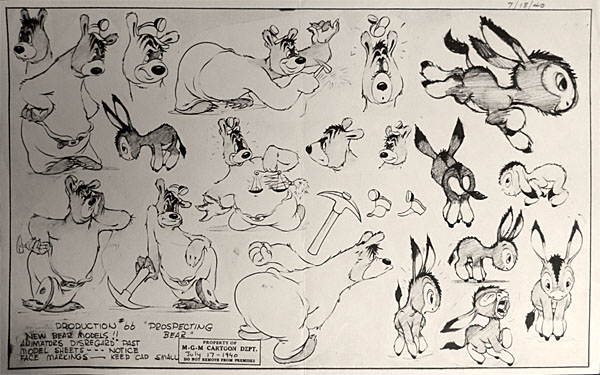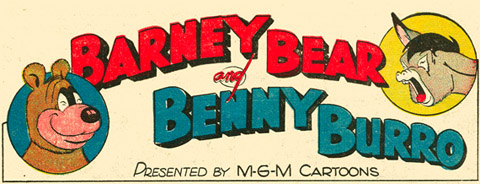
Today, we strike gold with Barney Bear in this week’s animator breakdown!
In the third cartoon featuring Barney Bear, not yet named in his early appearances, The Prospecting Bear pairs him with a troublesome burro that spends much of the film as an observer to Barney’s actions. Though the burro is nondescript and almost no dialogue spoken throughout in the cartoon, it serves as a precursor to the later pairing of Barney Bear and Benny Burro in comic book stories for Western Publishing’s Our Gang Comics, after appearing in earlier issues as Benny, “the Lonesome Burro.” Featured next to Barney in the comics, written and drawn by Carl Barks—and in later stories, drawn by Barks and written by Gil Turner— Benny often acted as the sensible half of the duo against Barney’s impulsive nature.
Rudy Ising, credited as producer (and as the director in the draft), offers a comic presence throughout the film, with Barney’s attempts in obtaining a large bounty of gold inside of a cave with a pickaxe and explosives. In theory, Barney’s indignities over his failures, in spirit of the comedy of embarrassment derived from different film comedians, are stronger than the film’s overall timing. Like many late 1930s/early ’40s animation directors who had not mastered frenetic pacing—or did not care to use it—sluggish pacing usually dampened their gags. “Slow-burn” frustration in live-action comedy did not often translate well into animation, appearing almost too sedentary.

The model sheet for The Prospecting Bear marks the date July 18th, 1940, though there is no date in the production draft when animation began. The animators credited on the draft are Pete Burness, Ray Abrams, Carl Urbano, Mike Lah, George Gordon and Dave Treffman. Burness’ scenes in the film retain his trademark bouncy, pose-to-pose movement in the first scenes of Barney bumbling along the steep ledges of a cliff, along with his exhausted burro, burdened with an enormous bundle of supplies. Later in the cartoon, Burness animates Barney lighting a stick of dynamite by the cave entrance, which blasts in his face seconds after. He registers an annoyed expression at the lit match, reminiscent of an Edgar Kennedy slow burn, and inadvertently flicks it with the remaining sticks of dynamite. After the box explodes in his face, he holds the frame of the box in front of him—a smoke-filled, droopy-faced self-portrait of humiliation.
Barney’s pantomime also bears some mannerisms lifted from Oliver Hardy; in a sequence animated by Carl Urbano, he looks to his burro in disapproval—twiddling his fingers on his small rock hammer—when he points out he has left the bundle between a rock and a fallen tree. At first, he tries to move the burro with a swift kick to the rear, but reconsiders with a gentle pat, which the burro still feels as unprovoked abuse. Later, in a scene animated by Mike Lah, when Barney swings his pickaxe at the cave, the curious burro obstructs him, and he signals him to scurry away so he can resume. This time, Barney does choose to threaten the burro with a kick as he rears back his foot, to which he quickly rushes back with the supplies.
Mike Lah’s timing/animation during his scenes of Barney’s skirmish with his pickaxe is snappier than the other animators, often using fewer drawings for a better impact. When Barney is ready to swing his pickaxe in a second attempt, Lah uses different spastic anticipation drawings—with dry-brush and abstract smears—before raising his arm to strike the rock to indicate his determination and ambition after his discovery of the gold inside the cave. After his pickaxe becomes stuck to the formation, continually vibrating, Barney walks away nonchalant, before grappling the handle and attempting to pull it out in a rapid succession of movement. It springs Barney back, crashing into his supplies, and finally, the pickaxe drops to the ground without his interference.

In most of the scenes credited to Dave Treffman, characters zip out of frame punctuated by dry-brush streak effects—besides its usage of the burro’s fear under the threat of being punished earlier in the film, it is mostly used for Barney’s frantic eagerness to extract gold. Ray Abrams is credited with some small scenes, which include the inter-cuts of the burro reacting to Barney, and much of the running gag in the film—his consumption of dynamite. George Gordon animates a section where the burro sniffs gunpowder, causing a small, eruptive sneezing fit. Gordon also animates the rest of the section with Barney and the gunpowder, as he takes the keg and a long fuse with him, which both end up in the back of his pants.
During the last few scenes of the film, Abrams animates Barney single-handedly carrying the heavy load of the explosives into the cave entrance. In the following scenes, Urbano animates his realization of how much dynamite the burro has swallowed, which elicits a hiccupping fit of detonating bursts. Just as Burness animates the beginning of the film, he animates the final sequences with Barney and the burro wedged inside the cave filled with dynamite and barrels of gunpowder. His animation continues after the resulting explosion that leaves the two trapped on top of a thin spire, as Barney registers a scornful look to the camera and the burro lowers his head in guilt.
Boxoffice magazine reported musical composer Scott Bradley wrote the score for this film by February 1st, 1941—the film was released to theaters the following month, on March 8th. One detail worth mentioning in the production draft—if readers tend to follow along with the breakdown video— is that the action in scene 5 (credited to Pete Burness) occurs in scene 3 (also by Burness). After the action in scene 4, scene 6 follows right after.
Enjoy! (It should be worth noting that almost every Barney Bear cartoon—with the exception of Rudy Ising’s Barney Bear’s Victory Garden and Dick Lundy’s The Little Wise Quacker—is available on the Boomerang app.)





Next month’s theme raises a good question: what were the songs Carl Stalling used under the original main titles on a number of Warner Bros. cartoons before they were re-issued under the “Blue Ribbon” banner? I’m sure some of you would love to know!
(Thanks to Michael Barrier and Ken Martinez for their help.)


 DEVON BAXTER is a film restoration artist, video editor, and animation researcher/writer currently residing in Pennsylvania. He also hosts a
DEVON BAXTER is a film restoration artist, video editor, and animation researcher/writer currently residing in Pennsylvania. He also hosts a 





















































































The backgrounds unmistakably show the Grand Canyon, and the music (Scott Bradley’s?) plays with Ferde Grofé’s 1931 “Grand Canyon Suite”.
I’d love to hear everyone’s thoughts on the Boomerang app, if you’re a subscriber. I can only assume most readers are used to owning collections on physical media. And do you watch the Boomerang app on a TV (through a Roku box or something similar)? Or do you prefer to consume it on a mobile device’s smaller screen?
We have the Boomerang app. My son watches it. It’s kid-oriented, certainly not collector-oriented. Their selection of classic cartoons is still pretty limited, so don’t have any expectations that they’ve thrown open the Warner-owned cartoon vaults and put them all on Boomerang.com
They have a bunch of the Famous Studios Popeye cartoons on there. (No Fleischer black-and-whites. Again, kid-oriented.) We (my son and I) were watching them the other day, and while he enjoyed them, I couldn’t get past how bad they looked. Many of them faded and looking pretty beat-up. Sure would be nice if Warner could do something with those before the negatives go to nitrate heaven.
I have an iPad
I like the exaggerated take when Barney looks inside the gold cave, with his eyes big as billiard balls. A glimpse at what the MGM animators would be doing under Tex Avery in just a few years.
Oh, this cartoon does indeed plod along…very…slowly, as did Hugh Harman’s “GOLDILOCKS AND THE THREE BEARS”, signaling their return to MGM once the CAPTAIN AND THE KIDS series fizzled out. In fact, if you listen to the Bradley score to “PROSPECTING BEAR”, there are little sections that play twice, signaling Harman and Ising’s penchant for showing their characters falling for the same trick twice. This was also apparent in one or two of the HAPPY HARMONIES titles, like “TWO LITTLE PUPS” where the tortured hen seems to find herself being physically lifted into the air by the squirts of water in a fountain that she stumbles into again and again, trying to get away from the pups’ continuous barking scares. The pairing of Barney Bear and Benny Burro were featured in TOM AND JERRY comics right up through the 1960’s apparently, because I remember buying such issues and seeing the occasional BARNEY BEAR series of panels. I wonder if those OUR GANG/BARNEY BEAR comics were reprinted in full color; I’d read a review of the book that first came out around them, and it mentioned that the comics were reprinted in black and white. Perhaps one of the most elaborate BARNEY BEAR titles produced by Ising at MGM that I can dimly recall is “THE FLYING BEAR”, especially the scene in which Barney and his anthropomorphic little plane crash at “Ceiling Zero” and plummet to earth, a scene that must have inspired Bob Clampett’s much more frenetic “FALLING HARE”. I’d like to know if Barney Bear really did look almost exactly like Papa Bear in Harman’s THREE BEARS series, because folks connected with filing the cartoons at MGM seem to file the THREE BEARS cartoons under the heading of BARNEY BEAR cartoons, as if a sub-file called BARNEY BEAR’S FAMILY. I remember Papa Bear as being a much gruffer character, bulkier and hairier, almost scarey-lookin’ on a black and white TV which is the only way I’d seen these cartoons until I saw “THE TOM AND JERRY FESTIVAL OF FUN” where “GOLDILOCKS AND THE THREE BEARS” was the earliest title included. Thanks for these MGM breakdowns. I hope more of these can be found, because there is much to talk about in those classics.
I have Boomerang. I’m here for the old Cartoons. They now have the Fleischer cartoons on there.